Input interpretation

tetralin
Chemical names and formulas

formula | C_10H_12 name | tetralin alternate names | 1, 2, 3, 4-tetrahydronaphthalene | tetrahydronaphthalene | tetralina | tetraline | Tetralin®solvent | tetranap mass fractions | C (carbon) 90.9% | H (hydrogen) 9.15%
Lewis structure

Draw the Lewis structure of tetralin. Start by drawing the overall structure of the molecule, ignoring potential double and triple bonds: Count the total valence electrons of the carbon (n_C, val = 4) and hydrogen (n_H, val = 1) atoms: 10 n_C, val + 12 n_H, val = 52 Calculate the number of electrons needed to completely fill the valence shells for carbon (n_C, full = 8) and hydrogen (n_H, full = 2): 10 n_C, full + 12 n_H, full = 104 Subtracting these two numbers shows that 104 - 52 = 52 bonding electrons are needed. Each bond has two electrons, so in addition to the 23 bonds already present in the diagram add 3 bonds. To minimize formal charge carbon wants 4 bonds. Identify the atoms that want additional bonds and the number of electrons remaining on each atom: Fill in the 3 bonds by pairing electrons between adjacent highlighted atoms. Note that the six atom ring is aromatic, so that the single and double bonds may be rearranged: Answer: | |
3D structure

3D structure
Basic properties
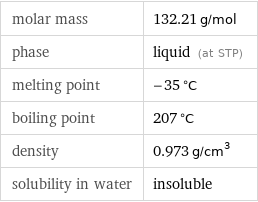
molar mass | 132.21 g/mol phase | liquid (at STP) melting point | -35 °C boiling point | 207 °C density | 0.973 g/cm^3 solubility in water | insoluble
Units

Liquid properties (at STP)
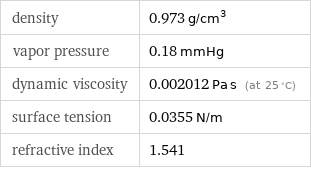
density | 0.973 g/cm^3 vapor pressure | 0.18 mmHg dynamic viscosity | 0.002012 Pa s (at 25 °C) surface tension | 0.0355 N/m refractive index | 1.541
Units

Thermodynamic properties
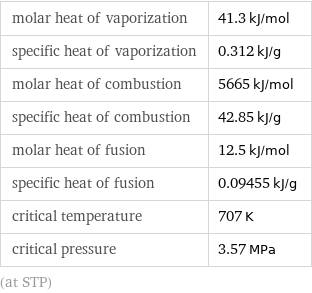
molar heat of vaporization | 41.3 kJ/mol specific heat of vaporization | 0.312 kJ/g molar heat of combustion | 5665 kJ/mol specific heat of combustion | 42.85 kJ/g molar heat of fusion | 12.5 kJ/mol specific heat of fusion | 0.09455 kJ/g critical temperature | 707 K critical pressure | 3.57 MPa (at STP)
Chemical identifiers
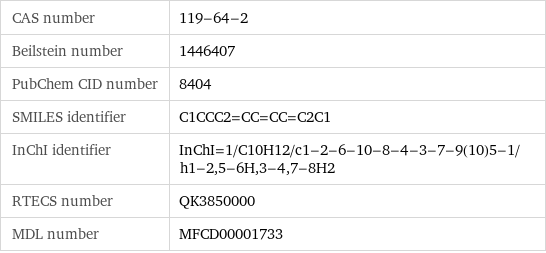
CAS number | 119-64-2 Beilstein number | 1446407 PubChem CID number | 8404 SMILES identifier | C1CCC2=CC=CC=C2C1 InChI identifier | InChI=1/C10H12/c1-2-6-10-8-4-3-7-9(10)5-1/h1-2, 5-6H, 3-4, 7-8H2 RTECS number | QK3850000 MDL number | MFCD00001733
NFPA label

NFPA label
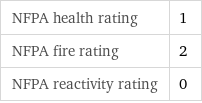
NFPA health rating | 1 NFPA fire rating | 2 NFPA reactivity rating | 0
Safety properties

flash point | 77.22 °C autoignition point | 385 °C lower explosive limit | 0.8% (concentration in air) upper explosive limit | 5% (concentration in air)

DOT hazard class | 4.1 DOT numbers | 1325
Toxicity properties

RTECS classes | tumorigen | primary irritant